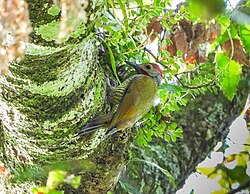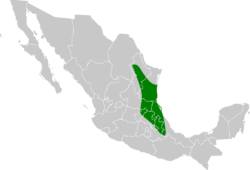Biology:Bronze-winged woodpecker
| Bronze-winged woodpecker | |
|---|---|

| |
| Scientific classification | |
| Domain: | Eukaryota |
| Kingdom: | Animalia |
| Phylum: | Chordata |
| Class: | Aves |
| Order: | Piciformes |
| Family: | Picidae |
| Genus: | Colaptes |
| Species: | C. aeruginosus
|
| Binomial name | |
| Colaptes aeruginosus (Malherbe, 1862)
| |

| |
| Synonyms | |
|
Colaptes rubiginosus aeruginosus[2] | |
The bronze-winged woodpecker (Colaptes aeruginosus) is a species of bird in subfamily Picinae of the woodpecker family Picidae. It is endemic to northeastern Mexico.[3]
Taxonomy and systematics
The bronze-winged woodpecker was originally described as Chrysopicus aeruginosus.[4] It was later placed in genus Piculus but since about 2007 has been moved into Colaptes by taxonomic systems. The International Ornithological Committee (IOC) and BirdLife International's Handbook of the Birds of the World consider it a species. The American Ornithological Society and the Clements taxonomy treat it as a subspecies of the golden-olive woodpecker (C. rubiginosus).[5][6][3][7][8][2]
The bronze-winged woodpecker is monotypic.[3]
Description
The bronze-winged woodpecker is 18 to 23 cm (7.1 to 9.1 in) long. Males and females have the same plumage except on their heads. Adult males have a slate gray forehead and crown with a red border back from above the eye to the red nape. They are pale buff to whitish from their lores around the eye to the red of the nape. They have a wide red malar stripe, a pale buffy white chin, and upper throat; the last has heavy blackish streaks. Adult females have red only on their nape. Both sexes have mostly green upperparts with a bronze tinge; their rump and uppertail coverts are paler and barred with dark olive. Their flight feathers are dark brownish olive with greenish edges and some yellowish on the shafts. Their tail is brown. Their underparts are pale buffy yellow with blackish olive scale-shaped bars. Their medium-length bill is slaty gray to black, their iris deep dull red, and the legs gray to olive-gray. Juveniles are generally duller than adults and have less well defined barring on their underparts.[9]
Distribution and habitat
The bronze-winged woodpecker is found in eastern Mexico between the states of Tamaulipas and Veracruz.[9] It inhabits subtropical dry forest, secondary forest, and plantations. In elevation it ranges from sea level to 2,100 m (6,900 ft)[1]
Behavior
Movement
As far as is known, the bronze-winged woodpecker is a year-round resident throughout its range.[9]
Feeding
The Cornell Lab of Ornithology's online Birds of the World does not describe the bronze-winged woodpecker's feeding techniques or diet separately from that of the golden-olive woodpecker sensu lato (which see here).[9]
Breeding
The bronze-winged woodpecker's breeding season is between January and May. As with foraging and diet, further data on breeding are not separated from those of the golden-olive woodpecker, which see here.[9]
Vocalization
The bronze-winged woodpecker's song is a "deliberate slow-paced series of...high-pitched calls, kwi, kwi, kwi, kwi, kwi, kwi"; it differs significantly from the "rising rattling trill" of the golden-olive woodpecker sensu stricto.[9]
Status
The IUCN has assessed the bronze-winged woodpecker as being of Least Concern. It has a large range, and though its population size is not known it is believed to be stable. No immediate threats have been identified.[1]
References
- ↑ 1.0 1.1 1.2 BirdLife International (2016). "Bronze-winged Woodpecker Colaptes aeruginosus". IUCN Red List of Threatened Species 2016: e.T61534039A95170597. doi:10.2305/IUCN.UK.2016-3.RLTS.T61534039A95170597.en. https://www.iucnredlist.org/species/61534039/95170597. Retrieved 28 January 2023.
- ↑ 2.0 2.1 Clements, J. F., T. S. Schulenberg, M. J. Iliff, T. A. Fredericks, J. A. Gerbracht, D. Lepage, S. M. Billerman, B. L. Sullivan, and C. L. Wood. 2022. The eBird/Clements checklist of birds of the world: v2022. Downloaded from https://www.birds.cornell.edu/clementschecklist/download/ retrieved November 10, 2022
- ↑ 3.0 3.1 3.2 "Woodpeckers". August 2022. https://www.worldbirdnames.org/new/bow/woodpeckers/.
- ↑ Malherbe, Alfred (1862) (in fr). Picidées ou Historire Naturelle. II. Metz: Société d'Histoire naturelle de la Moselle. pp. 171. https://www.biodiversitylibrary.org/page/40242186.
- ↑ Benz, Brett W.; Robbins, Mark B.; Peterson, A. Townsend (2006). "Evolutionary history of woodpeckers and allies (Aves: Picidae): Placing key taxa on the phylogenetic tree". Molecular Phylogenetics and Evolution 40 (2): 389–399. doi:10.1016/j.ympev.2006.02.021. PMID 16635580.
- ↑ Richard C. Banks, R. Terry Chesser, Carla Cicero, Jon L. Dunn, Andrew W. Kratter, Irby J. Lovette, Pamela C. Rasmussen, J. V. Remsen, Jr., James D. Rising, Douglas F. Stotz, and Kevin Winker. "Forty-ninth supplement to the American Ornithological Society’s Check-list of North American Birds". The Auk 2008, vol. 125:758-768 retrieved January 27, 2023
- ↑ HBW and BirdLife International (2022) Handbook of the Birds of the World and BirdLife International digital checklist of the birds of the world. Version 7. Available at: http://datazone.birdlife.org/userfiles/file/Species/Taxonomy/HBW-BirdLife_Checklist_v7_Dec22.zip retrieved December 13, 2022
- ↑ Chesser, R. T., S. M. Billerman, K. J. Burns, C. Cicero, J. L. Dunn, B. E. Hernández-Baños, R. A. Jiménez, A. W. Kratter, N. A. Mason, P. C. Rasmussen, J. V. Remsen, Jr., D. F. Stotz, and K. Winker. 2022. Check-list of North American Birds (online). American Ornithological Society. https://checklist.aou.org/taxa
- ↑ 9.0 9.1 9.2 9.3 9.4 9.5 del Hoyo, J., H. Winkler, D. A. Christie, and N. Collar (2022). Golden-olive Woodpecker (Colaptes rubiginosus), version 1.1. In Birds of the World (N. D. Sly, Editor). Cornell Lab of Ornithology, Ithaca, NY, USA. https://doi.org/10.2173/bow.goowoo1.01.1 retrieved January 27, 2023
Wikidata ☰ Q3382439 entry
 |


